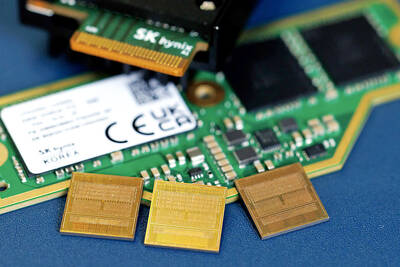Share prices of Coretronic Corp (
The company expects rear-projection, or digital light processing (DLP), projector shipments to rise to around 400,000 units this year from 170,000 units last year, spokesperson Cindy Wen (溫慧萍) said yesterday.
At an investor conference held on Monday in Taipei, chairman Wade Chang (張威儀) said the company would sell all it could produce and expected sales to rise to about NT$10 billion a year within five years.
"We're optimistic that we can hit that target," Wen said.
The top projector maker reported after-tax income for last year of NT$770 million, or NT$2.01 a share, on revenues of NT$23.9 billion, up 40 percent from the previous year.
Investors welcomed the company's forecast, sending shares of Coretronic up 7 percent to close at NT$42 on the TAIEX.
"It is highly possible that Coretronic could earn more this year due to growing demand for home-theater projectors because of falling retail prices," said Helen Chen (陳佩君), an analyst at Polaris Securities Group (寶來證券).
Chen forecast that Coretron-ic's earnings will double to NT$3.95 a share, in line with shipment growth this year.
Despite the downward pressure on projector prices, Coretronic will be able to sustain its gross margin at around 10.26 percent, the analyst said.
But the uncertain supply of key components such as bulbs could hurt the company's ability to reach the target, she warned.
A recent report released by market researcher Market Intelligence Center (MIC, 市場情報中心) showed that Taiwan's digital projector shipments for this year will rise to around 751,000 units, from 394,000 units last year.
"Digital projectors, which used to be a corporate-oriented product, are now making it onto the shopping list of general consumers," said MIC analyst Annabelle Hsu (
A sharp price decline during the second half of last year has spurred demand for home projectors, she added.
As projector prices fell to US$1,000 each, consumers have been more willing to choose digital projectors, rather than pricey flat-screen televisions, as a major part of their home entertainment systems, Hsu said.
"That will be a boon for digital projector manufacturers," Hsu said.
In addition to digital projectors, Coretronic also diversified into flat-screen televisions last year by producing plasma display panels (PDP) and rear-projection TVs mostly on a contract basis.
But the shipment volume remained small, with Coretronic producing just 1,000 PDP TVs and 5,400 rear-projection TVs during the last quarter, Wen said.

Nvidia Corp chief executive officer Jensen Huang (黃仁勳) on Monday introduced the company’s latest supercomputer platform, featuring six new chips made by Taiwan Semiconductor Manufacturing Co (TSMC, 台積電), saying that it is now “in full production.” “If Vera Rubin is going to be in time for this year, it must be in production by now, and so, today I can tell you that Vera Rubin is in full production,” Huang said during his keynote speech at CES in Las Vegas. The rollout of six concurrent chips for Vera Rubin — the company’s next-generation artificial intelligence (AI) computing platform — marks a strategic

REVENUE PERFORMANCE: Cloud and network products, and electronic components saw strong increases, while smart consumer electronics and computing products fell Hon Hai Precision Industry Co (鴻海精密) yesterday posted 26.51 percent quarterly growth in revenue for last quarter to NT$2.6 trillion (US$82.44 billion), the strongest on record for the period and above expectations, but the company forecast a slight revenue dip this quarter due to seasonal factors. On an annual basis, revenue last quarter grew 22.07 percent, the company said. Analysts on average estimated about NT$2.4 trillion increase. Hon Hai, which assembles servers for Nvidia Corp and iPhones for Apple Inc, is expanding its capacity in the US, adding artificial intelligence (AI) server production in Wisconsin and Texas, where it operates established campuses. This

Garment maker Makalot Industrial Co (聚陽) yesterday reported lower-than-expected fourth-quarter revenue of NT$7.93 billion (US$251.44 million), down 9.48 percent from NT$8.76 billion a year earlier. On a quarterly basis, revenue fell 10.83 percent from NT$8.89 billion, company data showed. The figure was also lower than market expectations of NT$8.05 billion, according to data compiled by Yuanta Securities Investment and Consulting Co (元大投顧), which had projected NT$8.22 billion. Makalot’s revenue this quarter would likely increase by a mid-teens percentage as the industry is entering its high season, Yuanta said. Overall, Makalot’s revenue last year totaled NT$34.43 billion, down 3.08 percent from its record NT$35.52

OPPORTUNITY: Supply of conventional DRAM chips tightened after the world’s major memory makers focused on manufacturing chips utilized in AI servers DRAM chipmaker Nanya Technology Corp (南亞科技) yesterday reported a spike in revenue for last month, as severe supply constraints prompted chip price hikes, almost doubling the company’s annual revenue last year from the previous year. Revenue soared 444.87 percent last month to NT$12.02 billion (US$381.4 million), from NT$2.21 billion a year earlier. That brought fourth-quarter revenue to NT$30.17 billion, from NT$6.58 billion for the same period in 2024. On a quarterly basis, revenue jumped 60.65 percent from NT$18.78 billion. Last year, revenue soared 95.09 percent to NT$66.59 billion from NT$32.13 billion in 2024, the company said. Supply of conventional DRAM